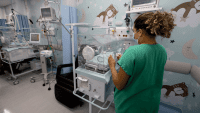Today’s hospital nurses and administrators need to improve the nursing work environment. This mandate is driven by unprecedented national efforts to address the intertwined issues of healthcare quality and nursing supply.
Given the global nursing shortage, improving the nursing work environment has become a worldwide issue. In the United States, the task of improving hospital nursing work environments rests primarily with the hospitals themselves. An extensive body of evidence confirms the relationships among positive work environments, positive nurse outcomes of job satisfaction and retention, and positive patient outcomes.
As the only source of data on the nursing work environment with a national scope, the RN Survey from the National Database of Nursing Quality(®(NDNQI®) is the preeminent source for research aimed at understanding, assessing, and improving the nursing work environment. In 2013, more than 315,000 direct-care registered nurses (RNs) working in 888 U.S. hospitals responded to this survey. No other survey collects data on so many characteristics of the nursing work environment from such a large number of practicing RNs. (See Average job enjoyment: 2004 to 2011.)
Applying results of previous NDNQI studies
Knowledge gained from this body of large-scale research can have practical implications from the unit-care level to the policy level. For example, the evidence suggests that nurse managers should ensure RNs receive appropriate work assignments and that hospitals would do well to retain older, more experienced RNs with longer tenure on their units. Also, nurse managers concerned about turnover could consider limiting the need for overtime and cutting back on mandatory floating.
Of course, more work needs to be done to improve the nursing work environment. Unfortunately, our understanding of this environment remains limited, which may impede the effectiveness of efforts to improve it. With resources limited as well, not every good improvement idea can be implemented. Thus, efforts must be chosen and targeted carefully.
Lessons from NDNQI-participating hospitals
NDNQI has gathered stories from hospital units on how they made changes that led to sustained improvement in the work environment. All of the stories have the elements of a typical quality-improvement approach:
- identifying targets for improvement
- developing and implementing plans for change
- measuring and monitoring the effects of interventions
- celebrating success
- maintaining efforts to ensure continued success.
Another common element of these stories is the importance of nursing leadership—specifically, teamwork between leadership and staff. Leadership played a large role in sustained improvement. Leadership changes occurred in many of the units for various reasons: Some units were newly formed, some filled a vacant leadership position, and some made changes when the leadership style didn’t match the unit’s needs. In each case, the new leaders strove to create a work environment that provided essential resources and support necessary to achieve high-quality nurse and patient outcomes on the unit.
The role of leadership was addressed through increased levels of RN involvement in unit decision-making. RN feedback was solicited in hiring nurse managers and other new positions, as well as in such day-to-day issues as scheduling and workflow. The Institute of Medicine’s report “The Future of Nursing: Leading Change, Advancing Health” recommended leaders facilitate RNs’ input in decision-making, as demonstrated through the use of shared governance and unit-based councils—not just to identify problems but to contribute to planning and implementing unit changes.
Staffing changes also played a major role in quality-improvement initiatives implemented on the units. Unique solutions to staffing issues included hiring additional support and ancillary staff, creating new positions, and adjusting staffing according to patient acuity changes. These adjustments led to several positive outcomes, including more favorable nurse-to-patient ratios, changes in care-delivery models, and more time for RNs to spend in direct patient care.
Finally, work-environment improvements were made by increasing support for advancing RN knowledge and skills. Initiatives were undertaken to educate, inform, and communicate more effectively within the unit and provide additional support for continuing education and training opportunities. Hospitals and units made efforts to encourage RN certification through promotion or other benefits, and nurse managers led by example in obtaining specialty certification.
Improving your organization’s work environment
To improve the work environment in your organization, you can adopt or modify the lessons learned from these outstanding units for any unit facing similar challenges. On a broad¬er scale, the improvement process can be used to bring change to any nursing environment. You can use the NDNQI RN Survey to assess your unit’s climate and needs and to identify areas for improvement. Also, you can develop and implement a targeted intervention based on your initial assessment, evaluate the effectiveness of the intervention using subsequent RN Survey reports, and retain or adapt the plan to improve your work environment continually.
Overall, the RN Surveys showed that enhanced leadership, staffing support, and support for continuing RN knowledge enhancement led to notable improvements within the units. Better outcomes for both nurses and patients were the most practical and important result of these improvements. Nurses’ satisfaction with their work environment increased, as did their intent to remain on the unit. Improved patient outcomes were reflected in increases in patient satisfaction and RNs’ perceived quality of care.
Selected references
Aiken LH, Cheung R. Nurse workforce challenges in the United States: Implications for policy. Organisation for Economic Co-operation and Development working paper 35. 2008. http://www.who.int/hrh/migration/Case_study_US_nurses_2008.pdf. Accessed November 20, 2013.
Buerhaus PI, Auerbach DI, Staiger DO. The recent surge in nurse employment: causes and implications. Health Aff (Millwood). 2009;28(4):w657-68.
Dunton N, Gajewski B, Klaus S, Pierson B. The relationship of nursing workforce characteristics to patient outcomes. Online J Iss Nurs. 2007;12(3):1-11. www.nursingworld.org/MainMenuCategories/ANAMarketplace/ANAPeriodicals/OJIN/TableofContents/Volume122007/No3Sept07/NursingWorkforceCharacteristics.aspx. Accessed November 22, 2013.
Klaus SF, Ekerdt DJ, Gajewski B. Job satisfaction in birth cohorts of nurses. J Nurs Manag. 2012;20(4):461-71.
Staggs VS, Knight JE, Dunton N. Understanding unassisted falls: Effects of nurse staffing level and nursing staff characteristics. J Nurs Care Qual. 2012;27(3):194-9.
The authors work at the University of Kansas Medical Center in Kansas City. Emily Cramer is a senior research associate and Nancy Dunton is a research assistant professor and director of the NDNQI program in the School of Nursing. Vincent Staggs is a research assistant professor of biostatistics in the School of Medicine.

















